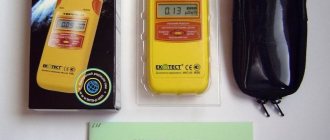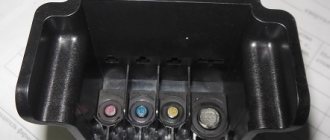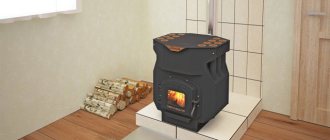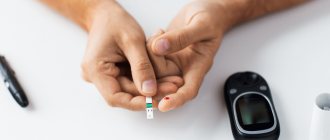Photometric and electrochemical glucometers
There are two methods for measuring blood glucose using a glucometer: electrochemical and photometric .
The photometric machine uses certain reagents that change the color of the test strip when it comes into contact with glucose. Such devices are considered not very reliable, since there are often cases of impaired color vision in patients with diabetes, which can complicate the reliability of deciphering the result. Moreover, they are susceptible to the influence of temperature - a sharp decrease or increase in temperature can cause inaccurate results.
The most reliable and convenient for home use is an electrochemical glucometer . In such devices, the blood falling on the test strips is read by electronic sensors. The reliability of the results is not affected by external factors.
How does Smart Backlight work in the Contour Plus One glucometer?
Smart Light instantly lets you know when your blood glucose reading is within, above, or below your target range.
The color indicator lights up in three colors, providing instant and clear feedback.
The colors are intuitive, using the “traffic light” principle: red (danger) for hypoglycemia, yellow (caution) for hyperglycemia, green for the target range. It is possible to configure target values individually and receive feedback on them using color indication.
The Application immediately displays the result with a similar color and prompts for action, which helps you make the right decision in a critical situation.
Rules for using a glucometer
Anyone can use this device at home. The main thing is to have consumables (test strips) in stock if the measurement is carried out using an invasive method. It is important to monitor their expiration date: damaged products will not provide the required accuracy.
Using a glucometer comes down to a few simple steps:
- thorough hand washing;
- disinfection of the puncture site;
- pricking the fingertip with a lancet;
- applying blood to the test strip;
- inserting the strip into the device.
The sequence of the last two steps depends on the type of device. The photometric strip is inserted with blood already applied. It is placed clean in the electrochemical one. There is no need to insert express strips anywhere. Just wait for the color to change. With non-invasive it is even easier. It is only necessary to ensure contact with the skin (the area depends on the type of device).
Please help me choose a glucometer based on my wishes.
In order to provide advice and assistance in choosing the right device, you can ask several clarifying questions, such as:
— How often should you measure your blood sugar levels?
— What is important to a person when measuring or what qualities of the device are important?
Using the “Contour” line as an example, let’s look at what glucometers can be offered depending on the buyer’s answers.
"Contour TS"
For people with diabetes:
— Who cares about taking measurements simply and “without any hassles” and getting an accurate result*.
— Who measures less than once a day.
Why?
You can start using it immediately after purchase - the glucometer does not require additional settings.
- Large screen to view the result.
- A small drop of blood is 0.6 µl.
- Measurement time - 5 seconds.
Contour Plus
For people with diabetes:
— Who cares about high accuracy and cost savings during self-monitoring.
— Who measures more than once a day.
Why?
- High accuracy exceeds the requirements of the current standard for blood glucose meters ISO 15197:2013**.
- Second Chance technology saves money on test strips if the first drop of blood was not enough to measure.
- Sound reminders about measurements will help you remember to take measurements on time.
What to look for when choosing a glucometer?
An important aspect when choosing a device is its cost. The price of a glucometer varies over a fairly wide range and depends on many factors. But it must be borne in mind that acquisition is not the only expense for conducting research.
The operating cost consists of the price of device consumables, such as test strips, lancets, and lancers. When choosing, you should familiarize yourself with the proposed package (whether test strips, lancets, etc. are included in the kit and in what quantity), and also evaluate the price of the materials necessary to conduct the study. This will allow you to calculate the cost of operating the device over a certain period of time.
Almost all models of modern glucometers are convenient and consumer-oriented. Most of them are compact in size, light in weight and easy to operate for everyone. Manufacturers produce products with fairly large screens and large fonts. For visually impaired patients, devices with a voice control function are suitable, which accompany the entire examination process with a voice, and also announce the result of the analysis. Some devices are even equipped with an alarm function, reminding a person at the necessary time of the need to carry out the procedure.
The speed of measuring blood sugar levels is different for each glucometer, generally the measurement time range is from 5 to 60 seconds. The length of the test does not affect its accuracy, however, for people suffering from severe forms of diabetes, a quick glucose measurement can save lives.
In order for a person to be able to choose a glucometer that is suitable for him, it is best to simply let him hold the device in his hands, try to perform some manipulations, go to the menu, and evaluate the convenience of the device. This will allow you to avoid making a mistake with your purchase, since the choice of a glucometer depends solely on individual preferences.
Should you trust your glucometer? Doctor of Medical Sciences, Professor Ametov A.S. answers the questions.
glucometer?
Doctor of Medical Sciences, Professor Ametov A.S. answers the questions. “Diabetes.Lifestyle” , Doctor of Medical Sciences, Professor, Head of the Department of Endocrinology and Diabetology of the Russian Medical Academy of Postgraduate Education of the Ministry of Health of the Russian Federation answers the questions.
Maria S., Orel: I have type 2 diabetes and am being observed at the district clinic. Once a month I take blood sugar tests in the laboratory at our clinic. Test results are often quite good: 6 mmol/l, 4.8 mmol/l, 5.1 mmol/l. The doctor says that everything is fine with me and my treatment is effective. When I measure my sugar on a glucometer during the day, very often the sugar exceeds 10-11 mmol/l. What should I do, what analysis is correct?
Ametov A.S. : The simplest reason for distrust of the frightening readings of a glucometer may be actual decompensation, which a person did not know about before purchasing the device. After all, most “experienced” diabetics are accustomed to donating blood for sugar once a month in a clinic. A person prepares for such an analysis in advance: a day or two before it, he “goes on” a strict diet, comes to the laboratory on an empty stomach - and most often his blood sugar turns out to be, if not normal, then somewhere close to it. But for the rest of the month he indulges in excess food, and his sugar “jumps.” Having entered the life of such a diabetic, a glucometer simply “opens” his eyes.
The patient's blood sugar changes quite quickly. In order to accurately say whether treatment is right for you, you need to measure your sugar both before meals and 1.5 - 2 hours after meals. Based on repeated measurements at different points of the day, a conclusion can be drawn about the correctness of the therapy. The glucometer is designed to help you with this, so as not to go to the laboratory several times a day.
WHO experts believe that the glucometer can give deviations of up to 20-25%. This will not affect your decision to treat your diabetes. After all, what is important to you and me is not a single measurement (no conclusions can be drawn from it), but the dynamics of blood sugar levels throughout the day, week, month.
Oleg M., Vladivostok: I simultaneously took a test in the laboratory for blood sugar from a finger prick and a biochemical blood test (blood from a vein). Sugar was also determined in a biochemical blood test, and there was a discrepancy in the results. Which analysis is correct? In the biochemical analysis - 7.2 mmol/l, and in the blood from the finger - 6.4 mmol/l?
Ametov A.S.: Both analyzes are correct. The fact is that biochemical analysis determines the sugar content in plasma, and the norms for plasma are slightly different: on average 12% higher than for whole blood (from a finger). Thus, the upper limit for whole blood is 5.5 mmol/l, and for plasma – 6.1 mmol/l. Therefore, in this case, it is necessary to focus on the boundaries of the norm, which are necessarily written on the analysis form. But if we talk about diagnosing diabetes, that is, directly about the moment of diagnosis, then it is necessary to pay attention to what the standards are for this device and how it is calibrated. If we talk about the patient’s daily self-monitoring, what is important here is, first of all, the dynamics of sugar during the day, and not a one-time result.
The reason for incorrect results on the glucometer may be, in particular, the patient’s mistakes in performing the test. For example, unwashed hands. In addition, for many types of test strips, the volume of a drop of blood is important - it must cover the entire test area with a “cap” so that the dry reagent of the strip absorbs enough plasma, and the device can read information from the entire area of the reactive zone. It is also important to wipe the first drop of blood from your finger: it contains interstitial fluid that interferes with the purity of the analysis.
You cannot check the glucometer according to the data of a laboratory where blood is taken for sugar from a vein: the level of glucose in venous and capillary blood is different. In addition, deviations in the readings of glucometers, which depend on many conditions - temperature and humidity, blood hematocrit and the use of medications not related to diabetes - may well be greater than the difference between the level of sugar in capillary blood, but how it was said that this does not affect the quality of treatment.
Svetlana T., St. Petersburg: I recently completed a diabetes school and became convinced of the need to purchase a glucometer. All my diabetic friends use devices calibrated using capillary whole blood. At the diabetes school I was told that glucometers have appeared in Russia that are calibrated by blood plasma, and, supposedly, they are more accurate. Please explain what the difference is and is this true?
Ametov A.S.: I must say right away that the accuracy of the readings does not depend on the method of calibrating the device. Answering the first part of your question, I would like to draw your attention to the fact that there is no fundamental difference between one and the other calibration method - you only need to know the norms of glucose levels in whole blood (if you have a device calibrated using whole blood) or in plasma (if Your meter is calibrated using plasma). It should be noted that plasma calibration of glucometers is accepted in countries such as the USA and most European countries. In Russia, self-monitoring of glucose in whole capillary blood is accepted as a criterion for compensation of carbohydrate metabolism in diabetes mellitus.
Tell your doctor how your device is calibrated - for plasma or whole blood, and specify how you should keep a self-monitoring diary.
Return to the “Glucometers” section
Is it possible to take blood from something other than a finger?
Traditionally, blood for testing is taken from a finger or from a vein. In the case of assessing sugar levels, venous is not very preferable. It contains more glucose than capillary, and there is a high risk of incorrect interpretation of the analysis. Therefore, blood for sugar is taken from a finger.
But there are many nerve endings in the fingertip. For many people, piercing is too painful. Therefore, there are high-quality glucometers that include the ability to analyze blood from:
- shoulder;
- forearms;
- shins;
- hips.
It's not that painful to pierce them. However, blood circulation in these parts of the body is slower than in the fingers. Therefore, changes in glucose levels do not always appear in a timely manner according to analyzes from alternative sites.
Device coding
Coding a glucometer is a procedure on which the accuracy of the results obtained depends. It allows you to bring the device itself and the test strips that come with it into maximum compliance. Older models required manual coding. It was replaced by electronic chips.
The most advanced devices do not require coding. It occurs automatically when the test strip enters the housing. The glucometer reads the code and configures itself.
No Coding technology was developed because it became apparent that most patients were not completing the necessary adjustments. The coding procedure cannot be ignored, since the accuracy of measurements is reduced. As a result, it is not possible to accurately determine the dose of insulin that needs to be administered to the patient.
For older people - special selection criteria
At the Krasnogorsk medical center, when choosing a glucometer, they advise, first of all, to take into account the patient’s age. Older people do not need to have a device with a huge amount of memory that will connect to a computer, calculate averages, and perform other functions. Practice shows that a large number of possibilities only confuses. High speed of blood measurement is also not the main criterion. The simplest models - without coding and without buttons - are a good choice.
The priority remains ease of use, a large screen with large numbers, a minimum of moving mechanisms, ease of holding in the hand (there are devices with a rubberized body), and the cost of test strips for a specific device. Please note that some manufacturers sell the glucometer itself at a low price, but its operation is expensive due to the high cost of consumables. Also check how widespread the stripes are and whether they are too small.
How to choose the right glucometer
You can see many models on the market. Equally high-quality devices differ in the degree of convenience for a particular user. You can understand which glucometer is best to buy for your home by answering a few questions:
- Which type of device is most convenient for you?
- Does the required blood volume matter? For the elderly, children and especially sensitive people, the depth of the puncture is important.
- Is measurement time important? Faster ones cost more, but not everyone needs them.
- What test strips are available in pharmacies near you?
- Is additional plasma calibration required? In simpler devices it is carried out through capillary blood.
- How much memory is needed? This determines how many last measurements can be recorded.
It is important to decide whether additional features are needed. Modern sugar meters can have a lot of them. But their presence is not necessary.
Additional functions of the meter
Typically, the device only measures the blood glucose concentration using a preset method. The kit includes the device itself, a set of test strips for the first time and a lancet for piercing the skin.
More expensive models come with statistical options, including separating measurements taken before and after meals. This is convenient for those who forget to fill out self-monitoring diaries.
A glucometer for an elderly or visually impaired person may have a voice assistant or a backlit display. The additional expense in this case is justified. You can also invest in an option with an auto-lancer, because not everyone has the fortitude to do it manually.
Options such as the ability to communicate with a computer or smartphone, the presence of extra control buttons and a timer are unimportant. Some sugar meters also analyze cholesterol levels.
The ideal glucometer: what is it?
Each patient has his own preferences. To make the right choice, note the requirements and wishes for the device. Having written down all the characteristics, the significance is established. Based on the importance, the device is selected.
Distinctive features of the devices:
- Measurement technique: electrochemical or photometric analysis. Photometry determines changes in the color of the test zone of the strip. The electrochemical method is based on measuring the current that appears when glucose reacts with glucose oxidase. The accuracy of the answers is approximately the same, but the electrochemical method is more convenient.
- Voice function. This is a good option for people with low vision. The device tells the patient what to do and pronounces the measurement result.
- Measurement parameters: glucose, ketone bodies. A wide range of analyzed parameters allows you to detect diabetes at an early stage and begin its treatment in a timely manner.











